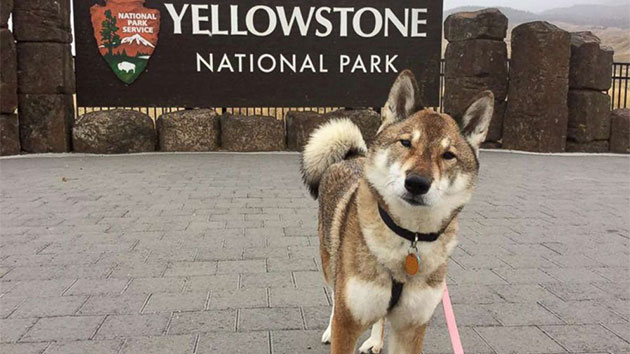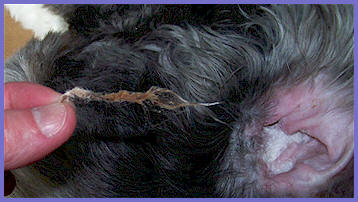Mayor Takes Terminally Ill Pet On Trip Across America
Paul Heroux, Mayor of Attleboro, Massachusetts
 When someone you love is terminally ill, you may do whatever you can to make the little time left count. Attleboro, Massachusetts Mayor Paul Heroux took his dying dog Mura on a cross-country bucket-list trip. The animal friendly politician has also gone to far lengths to make his government workplace a pet-friendly environment.
When someone you love is terminally ill, you may do whatever you can to make the little time left count. Attleboro, Massachusetts Mayor Paul Heroux took his dying dog Mura on a cross-country bucket-list trip. The animal friendly politician has also gone to far lengths to make his government workplace a pet-friendly environment.
Paul Heroux is the Mayor of Attleboro, Massachusetts. He tells us a very touching story about his dog, Mira. He says she is a Japanese Wolf dog, but that is not formally what the breed is called, that's just how he refers to her. Paul got Mira when she was eight weeks old. That was over 10 years ago and she'll turn 11 in February. He says she is the most precious thing in the world to him. She's his little family.
Unfortunately on September 21st, Mira was diagnosed with cancer. At the time, she was at work with Paul at City Hall. She walked over to him and he could tell something was wrong. When he picked her up, she suddenly fainted. He knew something was just wrong and he thought she was having an allergic reaction to some new treats.
He rushed her to the hospital and within a few minutes he knew the problem. They told him that her spleen had ruptured and she was bleeding internally. If she didn't get immediate surgery, she would have died that day. So of course Paul had the surgery done immediately. He ended up putting the expense on his credit card, as most people have to do in a situation like that.
After a week, he was contacted by the veterinary hospital. They said they had some bad news. They did a biopsy on the spleen and it turns out she has blood cancer.
The type of cancer Mira has is called hemangiosarcoma. Without treatment, she would only have lived one to three months from the time of diagnosis. That's about a 50-percent chance of living one to three months. With chemotherapy, she has a 50-percent chance of living six months and about a 10-percent chance of living one year.
Mira started on chemotherapy and she's gone through three of her six rounds. Paul is also trying her on a couple of other naturopathic type approaches that are backed up by research. He only puts her on stuff that's been supported by peer reviewed, published empirical research. He tells us turkey tail mushroom is one of those things. He knows it sounds hokey and corny, but the University of Pennsylvania published some good research on this couple of years back. This fights against the cancer like the chemotherapy does it. It's not going to cure her, as there is no cure at this point for what she has. The cancer is something that will eventually consume her. This is very upsetting to Paul, as Mira is his family and the most precious thing in the world to him.
Surprisingly, a dog can undergo chemotherapy very well and their hair doesn't fall out. However, Paul states that it does make her a little bit nauseous. He's also noticed that she loses her appetite a little bit, so he gives her a couple of appetite stimulants so she doesn't start to get weak or anything. He's also changed her diet over a to a pretty much all meat diet. He tells us he always gave her a very good dog food, the stuff you buy at the pet store as opposed to the grocery store. Mira is a wonderful little animal and has had a very good life; it's just unfortunate that Paul is going to lose her about four or five years early.
Paul tells us he hadn't been on vacation in over three years and was planning a trip to the Middle East when he got the bad news. He then felt if he had limited time with her, he was not going to spend it overseas for the next two weeks or any two weeks out of the limited time he has left with Mira.
This is when Paul decided to take a ride to go meet her breeder in Canada on Vancouver Island. So he drove out and along the way he stopped at a bunch of national sites like Niagara Falls, Mount Rushmore and Yellowstone National Park. He was taking pictures and nobody knew where he was going. He then started posting pictures of Mira on Facebook, because he says it's not really cute when the Mayor posts pictures of himself. However, people like it if you post pictures of a cute little dog going from one state to the next day and from one national site to another.
 After posting the pictures on Facebook, Paul says it caught on like a wildfire. By the time he got to Seattle, people had already been chiming in like crazy. The posts had been getting hundreds of hits. He had already picked up hundreds of new Facebook followers. At the end of the day, Paul states he picked up over 2,000 new Facebook followers.
After posting the pictures on Facebook, Paul says it caught on like a wildfire. By the time he got to Seattle, people had already been chiming in like crazy. The posts had been getting hundreds of hits. He had already picked up hundreds of new Facebook followers. At the end of the day, Paul states he picked up over 2,000 new Facebook followers.
On one post he said, "Filling up my gas tank: $40. Staying in a sketchy hotel: $60. The look on Mura's face after she just ate a nasty freeway gas station hot dog: Priceless."
Paul tells us Mira absolutely loved the hot dog. He cut it into little pieces and she gobbled it right up. She thought Christmas had come early for her. Unfortunately, it hit her later on.
He also thinks she liked seeing and smelling the bison when they were in Yellowstone National Park. Paul said he put down the window and was holding onto her harness so she wouldn't jump out the window and make a run for it. She really enjoyed seeing them and her little heart was pounding. Then there was also an elk that she got to see.
Overall, what Paul thinks Mira liked the best about the trip was spending time with him for 12 days, because they have a very special bond and to Paul, she's family. Plus, Mira doesn't know what national sites are, like Mount Rushmore, Niagara Falls or the Grand Canyon, none of that makes any difference to her, but she got to just spend time with him.
A lot of people ask Paul how can they get one of those dogs, because she's absolutely beautiful. He tells them, "Would you pick out your girlfriend based on looks - no! Well don't pick out a dog based on looks. You're asking for trouble. You have to have the right temperament." Paul states that he and Mira just have that right fit that a lot of people have with their dogs.
Fortunately, Mira is still with Paul. He says you wouldn't know that she has cancer if you met her. Her energy level is still just as what it used to be. She still has excitement for everyday. When he come homes, she's still happy to see him.
Paul wants to see Mira surpass the yearlong prognosis and that's why he's trying her on a couple of different things. He's had people reach out to him from literally all over the world suggesting that he try one thing or another. However, again, the only thing he wants to put her on is what's been peer reviewed and published in an academic journal.
There might even be something out there that people are experimenting with right now. For example, a lot of people say try CBD oil. But if Paul says there isn't any published peer reviewed research, he doesn't want to put her on it. CBD oil is everywhere. Paul says you can buy it on the Internet and you can even buy it in Providence, Rhode Island, which is not too far away from Massachusetts. He says a couple of years ago Massachusetts legalized marijuana through a ballot question. In Attleboro, Massachusetts, where he is the mayor, Paul says there are a number of shops that are opening up. CBD is a non-psychotropic element of the marijuana plant and it's becoming increasingly easy to find.
Paul tells us that he made Attleboro, City Hall pet friendly. Now when people come to City Hall, they sometimes bring their dogs and even their lizards. He says the employees are there doing government work all day and when all of a sudden somebody walks in with a little fur ball and it's like, "Oh, who's this?" People get excited and come out of their offices. They all then hover around this one little animal for maybe a couple minutes. Then they go back to their offices and they go back and sit down at their desk a little bit happier, which is good for everybody. Perhaps afterwards when they answer the phone, they're a little bit happier. They are also a little bit happier to do their work. So just having the animals come into the work environment really makes it a nicer work environment.
Mira has always been part of Paul's sideshow. When he was campaigning, she knocked on doors with him and stood outside of grocery stores when he collected signatures. She's also participated in parades and has visited senior homes and schools. She's been part of Paul's political identity for a long time.
In the end, Paul and Mira traveled 8,500 miles over 12 days, visiting 24 states and Canada. Paul now plans to write a children's book about their trip.
Visit Website
It's Not Doggie Asthma - It's a Reverse Sneeze - Dr. Debbie
 What dog owner hasn't heard that frightening sound that dogs make - part cough, part sneeze and often described as a dog being unable to catch his breath. But it really isn't asthma, or some kind of bone stuck in your dog's throat - it's a reverse sneeze. So before you panic and run into the veterinary office on emergency, ensure you know what a reverse sneeze is.
What dog owner hasn't heard that frightening sound that dogs make - part cough, part sneeze and often described as a dog being unable to catch his breath. But it really isn't asthma, or some kind of bone stuck in your dog's throat - it's a reverse sneeze. So before you panic and run into the veterinary office on emergency, ensure you know what a reverse sneeze is.
Meet the Reverse Sneeze
A reverse sneeze is a respiratory sound in a category all its own. Also known as a pharyngeal gag reflex or backwards sneeze, the reverse sneeze is a commonly observed respiratory sound in dogs, and less commonly in cats. While a true sneeze occurs on the exhale, the reverse sneeze occurs as the dog inhales. The result is a reverberating snorting, wheezing, episodic sound that lasts for a few seconds to a minute or two. A reverse sneeze is a completely harmless sound and dogs do not suffer any immediate health threat from these episodes.
How can you tell it's a reverse sneeze?
There is no easy explanation of the sound - you just have to hear it and you'll recognize it. Click to see and hear an example of a dog's reverse sneeze episode.
Part of my enjoyment on the weekly national radio program, Animal Radio®, is describing the peculiar smells, sounds and essences of veterinary medicine with our listeners. On many an occasion when speaking to callers, I have re-created the sounds of reverse sneezing. I'm no Rich Little, but I do take pride in my impersonation of a canine reverse sneeze, which is admittedly better in person with the visuals to complement the throaty sound.
Characteristics of a dog displaying a reverse sneeze include:
- Vibrational coughing/wheezing sound
- Stiff, extended neck
- Facial grimace
- No discharge from nose
- Not followed by coughing or vomiting up material
- Not involving collapse episodes
- Animal is completely normal after event
What causes a reverse sneeze?
Some reverse sneeze episodes occur when a dog gets very excited or pulls against a leash. Brachycephalic breeds (short faced breeds) like Pugs and Boston terriers commonly display reverse sneezing due to their upper airway conformation.
 Allergies, respiratory infections, nasal mites, inhaled foreign bodies and masses can also trigger reverse sneezing. Dogs with inflammatory conditions such as lymphoplasmacytic rhinitis can also display bouts of reverse sneezing. And sometimes reverse sneezing occurs in the wee hours of the night, while a dog is sleeping, for no apparent reason. In fact, many veterinarians receive panicked phone calls at 2am from pet owners, concerned of impending asthma attacks or respiratory arrest, only to have it turn out just to be a typical case of reverse sneezing.
Allergies, respiratory infections, nasal mites, inhaled foreign bodies and masses can also trigger reverse sneezing. Dogs with inflammatory conditions such as lymphoplasmacytic rhinitis can also display bouts of reverse sneezing. And sometimes reverse sneezing occurs in the wee hours of the night, while a dog is sleeping, for no apparent reason. In fact, many veterinarians receive panicked phone calls at 2am from pet owners, concerned of impending asthma attacks or respiratory arrest, only to have it turn out just to be a typical case of reverse sneezing.
What to Do?
There is no required treatment for a reverse sneeze episode. However, I recommend stroking a dog's throat while gently speaking to him in a calm manner until the episode subsides. Some advocate closing/pinching the nostrils off, which forces a dog to swallow and curtails the reverse sneeze episode. Whatever the approach, reverse sneezing episodes are over within minutes, so no emergency treatment is indicated. Antihistamines may be prescribed to minimize reverse sneezing episodes.
When to Worry?
If all of a sudden your dog is having repeated bouts of reverse sneezing, evaluation by your veterinarian is indicated. Consult with your veterinarian if your dog is reverse sneezing along with other symptoms such as facial rubbing, nasal bleeding, nasal discharge, coughing, or significant sneezing episodes.
Nasal mites are a common cause of reverse sneezing and may be noted after a recent boarding visit, especially if multiple dogs in a household are involved. Nasal mite treatment is easily pursued with anti-parasite injections of ivermectin (or in collie breeds - the alternative Milbemycin.) If reverse sneezing is excessive and prolonged, the nasal and pharyngeal areas should be evaluated by a veterinarian through rhinoscopy - a procedure performed under anesthesia in which the nasal passages and pharyngeal areas are visualized with an endoscope, a micro camera. This is how foreign objects and masses are typically identified. In other cases, further tests may be needed including a CT scan or with biopsy samples from sinus passages.
Final Thought
The good news is that most of reverse sneezing episodes are harmless, and do not indicate any serious illness. Arm yourself with information by learning what a reverse sneeze looks like and you may save yourself an unwanted emergency veterinary visit over this peculiar but non-life threatening occurrence.
Featured veterinarian known as "Dr. Debbie" on national pet radio program, Animal Radio. Ebook author of "Yorkshire Terriers: How to Be Your Dog's Best Friend"; "Pugs: How to Be Your Dog's Best Friend"; "Mini Schnauzers: How to Be Your Dog's Best Friend"; and "Shih Tzu: How to Be Your Dog's Best Friend." Dr. Debbie's books.
Visit Website
 The Dogfather's Grooming Tip with Joey Villani
The Dogfather's Grooming Tip with Joey Villani
Removing Hair From Dogs' Ears
Surprisingly, this topic is brought up frequently to Joey; when you're grooming your pet, do you remove the hair out of their ears or do you leave it?
Joey explains when he first learned how to groom; he was taught that you remove all the hair out of a dog's ears that had excessive hair growth. Usually the dogs that shed don't have much hair in their ears so you can leave it alone. However, dogs that don't shed, like a Shih Tzu, Maltese or Poodle, are the exceptions.
To remove hair from their ears, start by putting powder in their ears. This actually dries the ear canal. You can't just use any powder, you need to use a special powder made specifically for a dog's ears, which has antibiotic properties to it. This helps you get a grip so you can remove the hair.
Removing the hair from a dog's ear is probably not very comfortable for them, because you're pulling at it. It's sort of likes plucking eyebrows and they don't like it.
 Bottom line is this; they are now saying that you shouldn't be removing the hair at all. The reason why, and Joey completely agrees with this because it makes a whole lot of sense, is that what happens when you're removing the hair is that you're causing trauma to the skin inside of the ear canal. If your tools aren't sterile and you have any type of bacteria or anything that's on the equipment, that bacteria will go on to that irritated skin. This can lead to an infection.
Bottom line is this; they are now saying that you shouldn't be removing the hair at all. The reason why, and Joey completely agrees with this because it makes a whole lot of sense, is that what happens when you're removing the hair is that you're causing trauma to the skin inside of the ear canal. If your tools aren't sterile and you have any type of bacteria or anything that's on the equipment, that bacteria will go on to that irritated skin. This can lead to an infection.
Joey states that unless it's bothering your pet or your pet has ear infections, he would leave it up to your veterinarian and not your groomer or yourself to remove the hair. This is unless your veterinarian is telling you to have your groomer do it. Otherwise, just leave it there. If it's not bothering your dog, leave it alone.
Animal Radio News - Lori Brooks
 Pet Spending at $77 Billion Per Year
Pet Spending at $77 Billion Per Year
Earlier this year it was reported that Americans spent a staggering $69 and a half billion dollars on their pets in 2017. That number topped projected estimates for the year, which predicted that spending would reach $69.35 billion. Now, a new report indicates that even those figures were conservative and total US pet spending actually hit $77.1 billion in 2017. That's a notable 14.6-percent (or $9.8 billion) increase over spending in 2016. Just 5 years prior, pet spending topped out at almost $58 billion. What exactly are pet owners spending so much on? Pet food took the top spending spot and experts attribute the growth mainly to the trend toward feeding cats and dogs organic, raw and premium foods. According to the blog Pet Business Professor, consumers across all income levels spent more on pet food in 2017 than in the previous year. Will even more money be spent on pet food in the coming years? With forecasters predicting specialty pet diets will be one of the biggest pet care trends of 2019, it is expected that we'll probably be spending even more on pet food. Spending on pet supplies and veterinary care also increased in 2017. The only segment that saw a slight decline was pet services. However, it is believed that pet owners "traded" some of the money they would have normally used for services to spend more in other categories. It is still too early to report accurate numbers for 2018, but pet spending is expected to increase 3.7-percent overall for this year.
Family Gets Dog Back After Son Passed Away
An emotional reunion took place recently between a family in New York and their long-lost dog that ran away. The dog had belonged to the family's son who died after a tragic gun accident. The 5-year-old, blue-eyed brown and white Husky named Sinatra ran away and somehow ended up in Florida. The family that found Sinatra tried finding his owners, but the phone number on the chip was off by one digit. They then turned to social media and found his owners. It remains a mystery how the dog traveled 1,200 miles from New York to Florida, but Sinatra's family says having him back is better than Christmas.
 A Christmas Tree Just For Cats
A Christmas Tree Just For Cats
Cat lovers who celebrate Christmas, your tree prayers may have been answered. A company called Argos, which is a UK retailer, is selling six-foot-tall 'half parasol' trees. Picture an artificial Christmas tree with no limbs on the bottom 3 feet of the tree. Still, the diameter of the lowest branches is almost 4 feet! The half parasol Christmas trees sell for about $43. Flocked trees are $48.
Alligators at the Airport
Many airports around the country are helping to de-stress passengers with teams of therapy animals in the terminals. These mostly include dogs and the occasional therapy pig, which struts around the San Francisco airport, or the therapy cats in Denver or the miniature therapy horses that hoof it around the terminals at the Cincinnati/Northern Kentucky International Airport. Now, there is a new kind of therapy animal appearing every Friday from 1:30 to 3:00 p.m. at the Louis Armstrong New Orleans International Airport in Louisiana, where they have baby alligators at the baggage claim. The program is part of the airport's new partnership with the Audubon Nature Institute. Selfies are encouraged for that souvenir you won't soon forget. The little gators are used to being handled and are pretty small since they're babies and are about one to three feet long.
FDA Reducing Use of Animals in Research
In keeping with the goals of reducing, replacing and/or refining the use of animals in research, the Food and Drug Administration has released for public comment their proposed research to validate an alternative approach for what they call bioequivalence studies for certain animal drugs. Bioequivalence studies compare pharmaceutical products. For example, an original approved product with a proposed generic version. The FDA expects this new approach will provide animal drug makers with a scientifically sound method to demonstrate bioequivalence of certain drugs that does not require that dogs be euthanized as part of the study. Also, none of the dogs will be artificially infected with this new research plan and every effort will be made to ensure the animals' health from the time that they arrive at the test facilities until they are retired for adoption as pets. Another proposed change is that for at least two months before a study begins, the FDA's animal care staff will work with the dogs to socialize them and acclimate them to being handled. The dogs will also receive regular veterinary care, including vaccinations and preventive care, so that they remain happy, well socialized and healthy and thus able to be adopted. If you have comments, make them here.
 Dog Stands Guard Where Owner Was Killed
Dog Stands Guard Where Owner Was Killed
A dog that has been in the middle of a road for more than 80 days waiting for its owner to return has sparked an outpouring of interest and emotion on Chinese social media. A video of the dog emerged showing it standing guard near where its owner was reportedly killed back in August. Volunteers are trying to find relatives of the owner who died. Plenty of people have tried catching the dog that gets scared and moves away when people try to approach it. Many social media users have been quick to compare the dog to Japan's famous Hachiko, the Akita that waited for its dead owner for more than nine years outside a train station in Tokyo in the 1920's. Watch video.
 Listen to the entire Podcast of this show (#993)
Listen to the entire Podcast of this show (#993)





